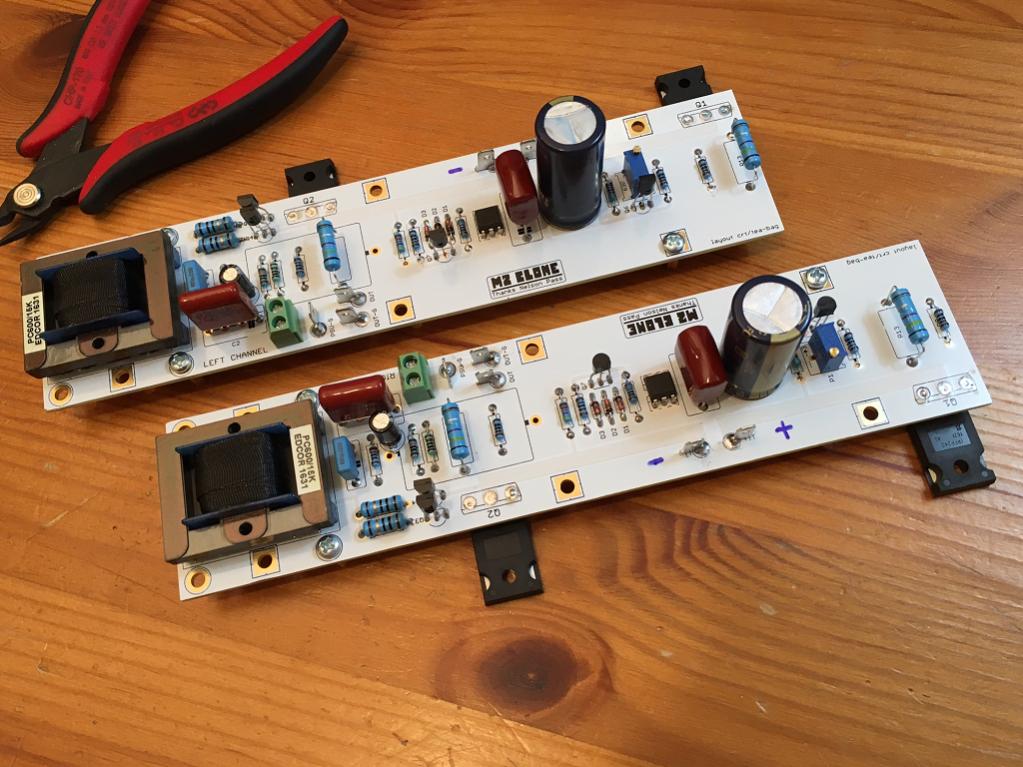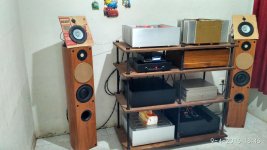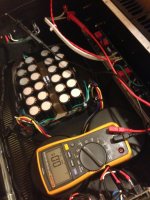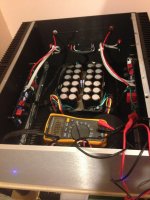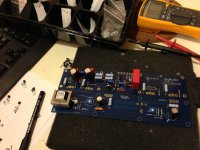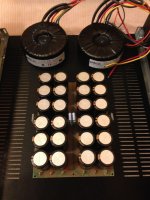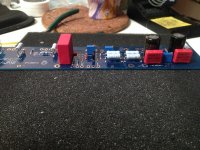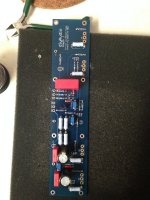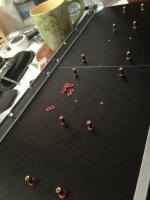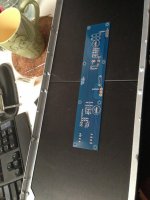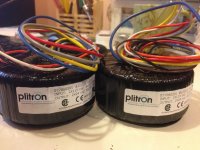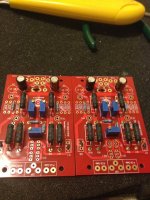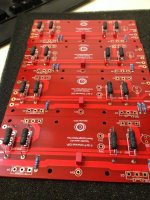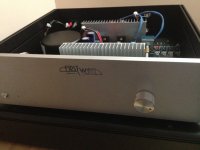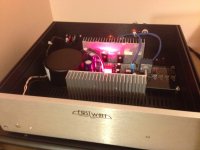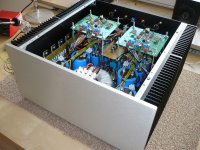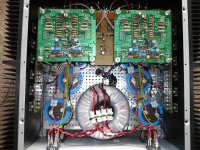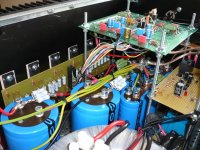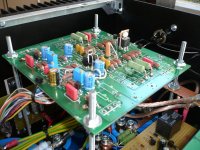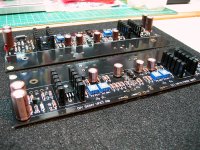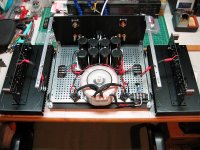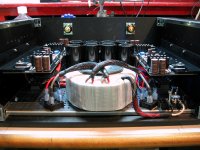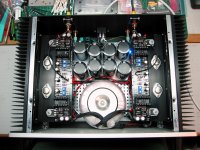My first Nelson Pass amp, F6
I was a little greedy about the size, wanted to build it into the smallest possible chassis.
Biased at 1A it has an OK heatsink temperature (52-55C), slightly high MOSFET temp (70C), but it gets hot inside the chassis, caps are quite warm. Thinking about forced cooling now..
It sounds great, absolutely. Very quite also

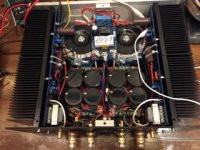
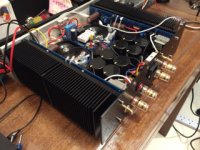
Sent from my iPhone using Tapatalk
I was a little greedy about the size, wanted to build it into the smallest possible chassis.
Biased at 1A it has an OK heatsink temperature (52-55C), slightly high MOSFET temp (70C), but it gets hot inside the chassis, caps are quite warm. Thinking about forced cooling now..
It sounds great, absolutely. Very quite also



Sent from my iPhone using Tapatalk
Yes, good idea. Hope it won't look too ugly 🙂
I have a similar approach in my next F5 build, spacing between most of panels

Sent from my iPhone using Tapatalk
I have a similar approach in my next F5 build, spacing between most of panels

Sent from my iPhone using Tapatalk
My first Nelson Pass amp, F6
I was a little greedy about the size, wanted to build it into the smallest possible chassis.
Biased at 1A it has an OK heatsink temperature (52-55C), slightly high MOSFET temp (70C), but it gets hot inside the chassis, caps are quite warm. Thinking about forced cooling now..
It sounds great, absolutely. Very quite also
Sent from my iPhone using Tapatalk
Can you post some bigger pictures? Because I think your work deserves it 😀🙂
BTW: 'The game of love' and 'Within' are my favorites......😉
PLLXO biamp
I have used alpair 10p in BR using my existing floorstand box, I should have started to build FHXL but still got no confidence about it. While keep reading on various options, I finally take my choice on Open Baffle.
Using information from here
TLS.org | Passive Line-Level Crossover
I tried to simulate what I have now.
High pass 1st order use directly from SIT L'amp circuit, with its input impedance 24K and change Cin to 35nF, should give 190Hz HP.
Low pass 1st order calculated with J2 input impedance 100K, i use RC filter 10K + 0.1uF which should give 160Hz LP.
this is not ideal value, because thats component value that I have on my drawer especially on low value capacitor. 35nf for SIT is using 2series 68nf mkt1813 which I'm not sure as a good Cin. beside that I have no any measuring tools hence only rely on my ears.
Alpair is supported by tweeter with 1uf filter on cardboard, while low bass use my floorstand woofer. its been running more than 12hr since yesterday, more I listen to this new system give me something new. I love how singer voice is produced, which I call it 'light and crispy' compared to box speaker which is 'heavy'. Really happy to have it now eventhough still not fully designed well.
I'm waiting my 2nd baby born in next 2 month, hopefully a girl 😀 first birth twin boys that already 4yr now. hence no more spending on audio until next year, the Alpair was my last purchase months ago. Maybe next year I will build this OB properly with 2 eminence beta 15" per side inspired by this build http://www.diyaudio.com/forums/full-range/162529-alpair-12-open-baffle-designs-4.html#post3862189
with my 7" woofer which has lower sensitivity than eminence but J2 is still powerfull enough, hopefully its not wasting heat on using J2 as bass amp 😀 if more power needed, I might use M2 or aragon2004.
I have used alpair 10p in BR using my existing floorstand box, I should have started to build FHXL but still got no confidence about it. While keep reading on various options, I finally take my choice on Open Baffle.
Using information from here
TLS.org | Passive Line-Level Crossover
I tried to simulate what I have now.
High pass 1st order use directly from SIT L'amp circuit, with its input impedance 24K and change Cin to 35nF, should give 190Hz HP.
Low pass 1st order calculated with J2 input impedance 100K, i use RC filter 10K + 0.1uF which should give 160Hz LP.
this is not ideal value, because thats component value that I have on my drawer especially on low value capacitor. 35nf for SIT is using 2series 68nf mkt1813 which I'm not sure as a good Cin. beside that I have no any measuring tools hence only rely on my ears.
Alpair is supported by tweeter with 1uf filter on cardboard, while low bass use my floorstand woofer. its been running more than 12hr since yesterday, more I listen to this new system give me something new. I love how singer voice is produced, which I call it 'light and crispy' compared to box speaker which is 'heavy'. Really happy to have it now eventhough still not fully designed well.
I'm waiting my 2nd baby born in next 2 month, hopefully a girl 😀 first birth twin boys that already 4yr now. hence no more spending on audio until next year, the Alpair was my last purchase months ago. Maybe next year I will build this OB properly with 2 eminence beta 15" per side inspired by this build http://www.diyaudio.com/forums/full-range/162529-alpair-12-open-baffle-designs-4.html#post3862189
with my 7" woofer which has lower sensitivity than eminence but J2 is still powerfull enough, hopefully its not wasting heat on using J2 as bass amp 😀 if more power needed, I might use M2 or aragon2004.
Attachments
My first Nelson Pass amp, F6
I was a little greedy about the size, wanted to build it into the smallest possible chassis.
Biased at 1A it has an OK heatsink temperature (52-55C), slightly high MOSFET temp (70C), but it gets hot inside the chassis, caps are quite warm. Thinking about forced cooling now..
It sounds great, absolutely. Very quite also
OK, posting pictures from phone did not work that well. Here is the better view of the insides
Note to myself: plan for access to trimpots and source resistors when thinking over the design
An externally hosted image should be here but it was not working when we last tested it.
https://postimage.org/index.php?lang=russianF6 build
Took vacation last month and built F6 during nights...
Don't have multi-turn pot in hand, use single turn for now...will replace to 3296 later...
No issue setting bias and DC offset.
Match Toshiba 2SK170 and 2SJ74 to identical value by myself - time consuming process, really need patience ...
4U 400 full aluminum chassis, heat sinks temperature remains under 50 Celsius.
As expected, lovely sound amp, very good bass, super sound stage. Love it!
Took vacation last month and built F6 during nights...
Don't have multi-turn pot in hand, use single turn for now...will replace to 3296 later...
No issue setting bias and DC offset.
Match Toshiba 2SK170 and 2SJ74 to identical value by myself - time consuming process, really need patience ...
4U 400 full aluminum chassis, heat sinks temperature remains under 50 Celsius.
As expected, lovely sound amp, very good bass, super sound stage. Love it!
Attachments
-
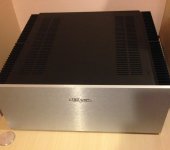 chassis.jpg107.3 KB · Views: 413
chassis.jpg107.3 KB · Views: 413 -
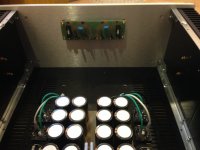 Bridges.jpg135.8 KB · Views: 412
Bridges.jpg135.8 KB · Views: 412 -
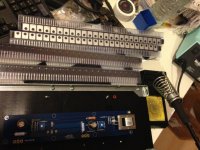 IMG_3035.jpg186.3 KB · Views: 397
IMG_3035.jpg186.3 KB · Views: 397 -
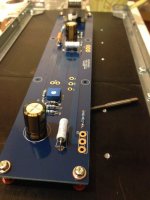 IMG_3016.jpg148.6 KB · Views: 394
IMG_3016.jpg148.6 KB · Views: 394 -
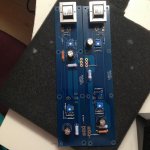 F6_Top.jpg195.8 KB · Views: 388
F6_Top.jpg195.8 KB · Views: 388 -
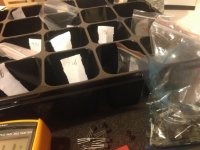 Matching.jpg159.3 KB · Views: 314
Matching.jpg159.3 KB · Views: 314 -
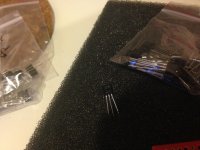 K170.jpg154.1 KB · Views: 292
K170.jpg154.1 KB · Views: 292 -
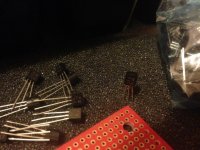 J74.jpg190.8 KB · Views: 355
J74.jpg190.8 KB · Views: 355 -
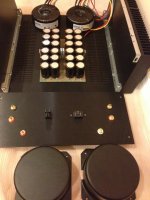 IMG_3013.jpg164.7 KB · Views: 371
IMG_3013.jpg164.7 KB · Views: 371 -
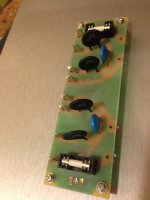 FrontPanel_PCB.jpg116.2 KB · Views: 626
FrontPanel_PCB.jpg116.2 KB · Views: 626
AJ Build
AJ build last month...
Toshiba 2SJ74 matched to identical value.
Turn on thump barely can be noticed (shadowed by power switch, it took me a while to "find" it by pressing ear against speaker while push the power switch on), turn off thump is also very gentle, you can hear it, but will not get surprised or worried....
Bias and offset adjusting no sweat...AJ is also a very good amp.
I'm using Seas 3 way classic DIY speaker.
5U 500mm full aluminum chassis. Biased at 0.85A per FET, heat sinks temperature below 50 Celsius...
AJ build last month...
Toshiba 2SJ74 matched to identical value.
Turn on thump barely can be noticed (shadowed by power switch, it took me a while to "find" it by pressing ear against speaker while push the power switch on), turn off thump is also very gentle, you can hear it, but will not get surprised or worried....
Bias and offset adjusting no sweat...AJ is also a very good amp.
I'm using Seas 3 way classic DIY speaker.
5U 500mm full aluminum chassis. Biased at 0.85A per FET, heat sinks temperature below 50 Celsius...
Attachments
Last edited:
Still need a case but everything is looking and sounding good. Absolutely dead silent with no music on. DC coupled in and out - no caps in audio path.
F5 Head Amp.
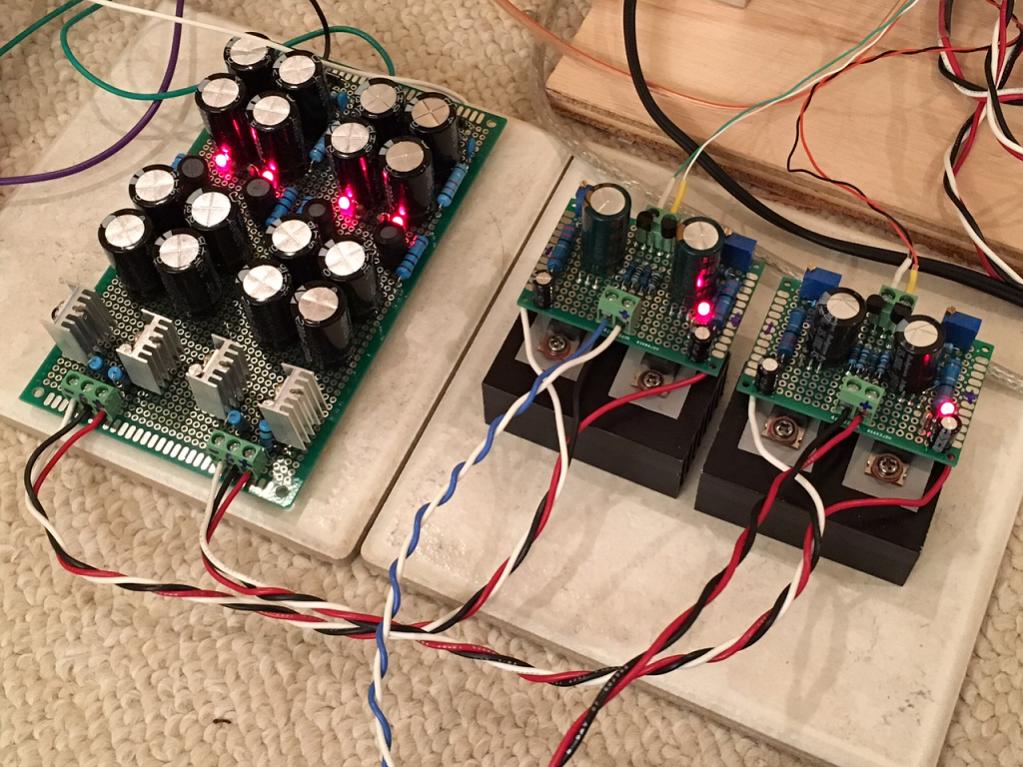
F5 Head Amp.

Aleph X
Hello,
this is my Aleph 30X build, my second diy project since the B1. I used the hifizen (?) boards but with the values of the Aleph 30, so there are 12 IRF240 per chanel. The PSU is CRCRC with 308000uF per chanel and about 26V on the rails. I had big problems with hum: i solved it with more capacitors, an star ground and an very good transformer from poland. There is also an net-filter and an speaker delay (schematic as here in the diyaudiostore but without protection). When the amp is warm after about one hour the heatsinks are in the range of 55-60 degree celsius, the relative offset then is +- 1mV and the absolut offset less then 100mV. To get the amp stable there is an thermal compensation on the heatfin of the css mosfet. That was the most effective place. The case is italian made. I like the sound very much!
Greetings, Michael
PS: thanks to Mr. Pass and all the other persons here in the forum. Without this knowledgebase for me it would have been absolutly impossible to handle such an project! Thanks!!
Hello,
this is my Aleph 30X build, my second diy project since the B1. I used the hifizen (?) boards but with the values of the Aleph 30, so there are 12 IRF240 per chanel. The PSU is CRCRC with 308000uF per chanel and about 26V on the rails. I had big problems with hum: i solved it with more capacitors, an star ground and an very good transformer from poland. There is also an net-filter and an speaker delay (schematic as here in the diyaudiostore but without protection). When the amp is warm after about one hour the heatsinks are in the range of 55-60 degree celsius, the relative offset then is +- 1mV and the absolut offset less then 100mV. To get the amp stable there is an thermal compensation on the heatfin of the css mosfet. That was the most effective place. The case is italian made. I like the sound very much!
Greetings, Michael
PS: thanks to Mr. Pass and all the other persons here in the forum. Without this knowledgebase for me it would have been absolutly impossible to handle such an project! Thanks!!
Attachments
Congratulations Michael! it's always nice to see an Aleph-X. By the way,
those are really fantastic offset figures.
Cheers,
Dennis
those are really fantastic offset figures.
Cheers,
Dennis
Thank you, Dennis! The relative offset never was a problem, but the absolut offset was drifting and not to stabilize with the original circuit. But i found a post in the Aleph-X builders thread about putting temperatur sensors in the circuit. The solution in my case was to substitute R24 (475Ohm) with to KTY81-110 in parallel. This devices are glued with thermal grease on Q6. This works very good.
Here's my diy Sony VFET amp. Burned it in for several multi-hour sessions with test speakers. All is well and sounding great.
- store 4U deluxe chassis
- heatsinks adapted for external removal
- baseplate drilled/tapped - no fiddly nuts!
- wired for easy component removal
- TeaBag 40mm PS + Panasonic TS-HA caps
- Elliott style GLB
- 2x22V 400VA SumR/Primrose shielded transformer - specially wound for Class A
- "neat & tidy" wiring
- matched IRFP240/IRFP9240
- matched 2SJ313/2SK2013
- matched 2SJ74BL/2SK170BL
- Silmic II caps
Many thanks to Nelson Pass and the rest of the "project VFET" team for making all this possible!
BK
- store 4U deluxe chassis
- heatsinks adapted for external removal
- baseplate drilled/tapped - no fiddly nuts!
- wired for easy component removal
- TeaBag 40mm PS + Panasonic TS-HA caps
- Elliott style GLB
- 2x22V 400VA SumR/Primrose shielded transformer - specially wound for Class A
- "neat & tidy" wiring
- matched IRFP240/IRFP9240
- matched 2SJ313/2SK2013
- matched 2SJ74BL/2SK170BL
- Silmic II caps
Many thanks to Nelson Pass and the rest of the "project VFET" team for making all this possible!
BK
Attachments
- Home
- Amplifiers
- Pass Labs
- Pictures of your diy Pass amplifier
